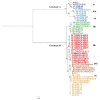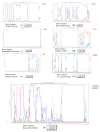Chicken Astrovirus (CAstV) Molecular Studies Reveal Evidence of Multiple Past Recombination Events in Sequences Originated from Clinical Samples of White Chick Syndrome (WCS) in Western Canada
- PMID: 32998356
- PMCID: PMC7600043
- DOI: 10.3390/v12101096
Chicken Astrovirus (CAstV) Molecular Studies Reveal Evidence of Multiple Past Recombination Events in Sequences Originated from Clinical Samples of White Chick Syndrome (WCS) in Western Canada
Abstract
In this study, we aimed to molecularly characterize 14 whole genome sequences of chicken astrovirus (CAstV) isolated from samples obtained from white chick syndrome (WCS) outbreaks in Western Canada during the period of 2014-2019. Genome sequence comparisons showed all these sequences correspond to the novel Biv group from which no confirmed representatives were published in GenBank. Molecular recombination analyses using recombination detection software (i.e., RDP5 and SimPlot) and phylogenetic analyses suggest multiple past recombination events in open reading frame (ORF)1a, ORF1b, and ORF2. Our findings suggest that recombination events and the accumulation of point mutations may have contributed to the substantial genetic variation observed in CAstV and evidenced by the current seven antigenic sub-clusters hitherto described. This is the first paper that describes recombination events in CAstV following analysis of complete CAstV sequences originated in Canada.
Keywords: chicken astrovirus; molecular epidemiology; recombination; runting-stunting syndrome; white chick syndrome; whole genome sequencing.
Conflict of interest statement
The authors declare no conflict of interest.
Figures





Similar articles
-
An Insight into the Molecular Characteristics and Associated Pathology of Chicken Astroviruses.Viruses. 2022 Mar 30;14(4):722. doi: 10.3390/v14040722. Viruses. 2022. PMID: 35458451 Free PMC article. Review.
-
Detection and molecular characterization of chicken astrovirus associated with chicks that have an unusual condition known as "white chicks" in Brazil.Poult Sci. 2016 Jun 1;95(6):1262-70. doi: 10.3382/ps/pew062. Epub 2016 Mar 14. Poult Sci. 2016. PMID: 26976903 Free PMC article.
-
White Chick Syndrome Associated with Chicken Astrovirus in Ontario, Canada.Avian Dis. 2018 Jun;62(2):247-258. doi: 10.1637/11802-012018-Case.1. Avian Dis. 2018. PMID: 29944402
-
Turkey Astrovirus Type 1 (TAstV-1) and Chicken Astrovirus (CAstV) Detection in Brazilian Chicken Flocks.Avian Dis. 2016 Sep;60(3):681-7. doi: 10.1637/11403-030816-ResNote.1. Avian Dis. 2016. PMID: 27610731
-
A Review of the Strain Diversity and Pathogenesis of Chicken Astrovirus.Viruses. 2017 Feb 10;9(2):29. doi: 10.3390/v9020029. Viruses. 2017. PMID: 28208602 Free PMC article. Review.
Cited by
-
Genome Sequences and Characterization of Chicken Astrovirus and Avian Nephritis Virus from Tanzanian Live Bird Markets.Viruses. 2023 May 25;15(6):1247. doi: 10.3390/v15061247. Viruses. 2023. PMID: 37376547 Free PMC article.
-
Molecular characterization of chicken astrovirus and pathogenicity of a novel isolate in China.Front Microbiol. 2023 Dec 11;14:1280313. doi: 10.3389/fmicb.2023.1280313. eCollection 2023. Front Microbiol. 2023. PMID: 38149277 Free PMC article.
-
Comparative genomics of Japanese encephalitis virus shows low rates of recombination and a small subset of codon positions under episodic diversifying selection.PLoS Negl Trop Dis. 2024 Jan 31;18(1):e0011459. doi: 10.1371/journal.pntd.0011459. eCollection 2024 Jan. PLoS Negl Trop Dis. 2024. PMID: 38295106 Free PMC article.
-
An Insight into the Molecular Characteristics and Associated Pathology of Chicken Astroviruses.Viruses. 2022 Mar 30;14(4):722. doi: 10.3390/v14040722. Viruses. 2022. PMID: 35458451 Free PMC article. Review.
-
Pathogenesis of Chicken Astrovirus Related Illnesses.Front Vet Sci. 2022 Jun 10;9:899901. doi: 10.3389/fvets.2022.899901. eCollection 2022. Front Vet Sci. 2022. PMID: 35754540 Free PMC article. Review.
References
-
- Saif Y.M., Guy J.S., Day J.M., Cattoli G., Hayhow C.S. Viral Enteric Infections. In: Swayne D., editor. Diseases of Poultry. Elsevier; Cambridge, MA, USA: 2020. pp. 401–445.
Publication types
MeSH terms
LinkOut - more resources
Full Text Sources
Miscellaneous

